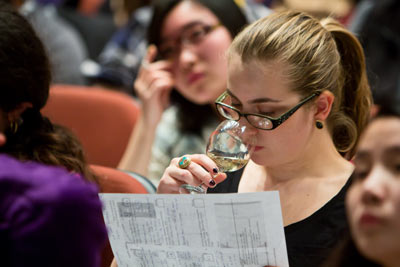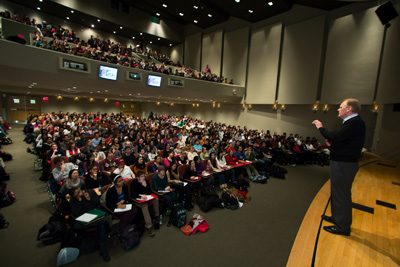Intro to Wines: A classic vintage turns 40
By Sherrie Negrea



At 2:55 p.m., Stephen Mutkoski '67, Ph.D. '76, walks onto the stage of Alice Statler Auditorium and bellows, "Good afternoon, everyone!" The throng of 700 students comes to attention. They are lucky to have won placement in Introduction to Wines, Cornell's most popular elective course, and no one wants to miss a drop.
Today's lesson is about the components of wine: flavor, appearance, structure, texture and impact. The students begin by tasting a series of wine samples that Mutkoski, the Banfi Vintners Professor of Wine Education and Management at the School of Hotel Management, has enhanced to bring out "certain organoleptic properties."
Mutkoski says he wants the students to learn how to evaluate a wine's aroma, not just its taste. "That's what gives us 80 percent of our enjoyment of wine and food."
Many samples later, he asks about No. 7: "Do you pick up any particular characteristic?" One student yells out "Apple!" Another says "Pear!" When a third shouts "Grapefruit!" Mutkoski's eyes light up. "You got it! Grapefruit! This is a sample of a Sauvignon Blanc that has that grapefruit essence to it."
More than 41,000 undergraduate and graduate students have taken this iconic course since 1972, when it was first offered universitywide. While sipping wine one afternoon a week may seem to be the main attraction, many students said they enrolled to learn a skill they believe will prove useful in their future careers. "I think it's important to be able to understand wine, especially in the business world," said Ariel Frank '12 of the ILR School.
Alison Napjus '99, now a wine reviewer and writer for Wine Spectator, says the course helped her learn to approach the study of wines from the standpoint of the classic regions -- and helped her land her job.
"The director who hired me said I was the only one who had ever aced his wine quiz," recalled Napjus. "I went into the interview without any studying. It was two years after I had taken that class. That class prepped me for this interview, and I was able to get this job."
Mutkoski has taught the class since 1983, shaping it into a consumer-oriented course that covers the culture and history of the world's wine regions, how to select wine in a restaurant or retail shop and the pairing of wines with different cuisines. Vintners from the United States discuss their wines with the class via telephone, and Mutkoski hopes to soon add videoconferencing to the course.
"This is a broadening kind of cultural-enrichment course where people get to learn something about other countries that they haven't been to," Mutkoski explained. "In the case of an Italian wine, you have to understand some aspects of the Italian language, culture, wine laws and requirements."
Mutkoski devotes one lecture to the risks and benefits of consumption and invites Tim Marchell, director of mental health initiatives at Gannett Health Services, to discuss the need for a balanced view of alcohol.
By the end of the semester, he expects the students to have a skill they will value whether they entertain clients or simply want to order off a restaurant's wine list. "In 14 weeks, we try to give them as much of a start as possible on a process that could take a lifetime to complete. The joy for me is that I teach a subject that people can continue to learn about, appreciate and use for the rest of their lives."
Sherrie Negrea is a freelance writer in Ithaca, N.Y. This article has been abridged from the spring 2012 issue of Hotelie magazine.
Media Contact
Get Cornell news delivered right to your inbox.
Subscribe